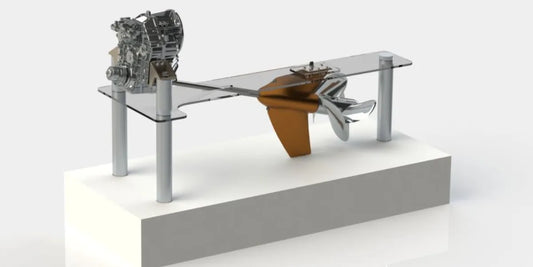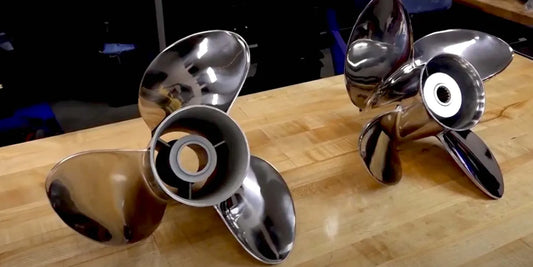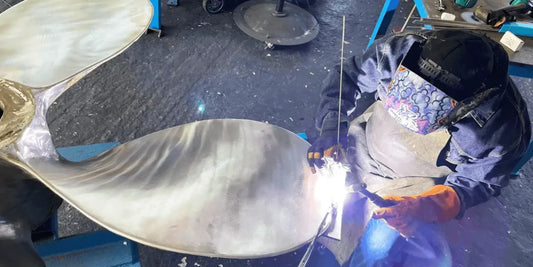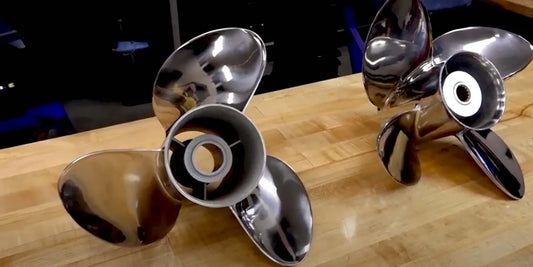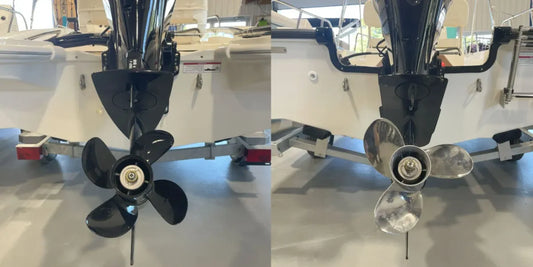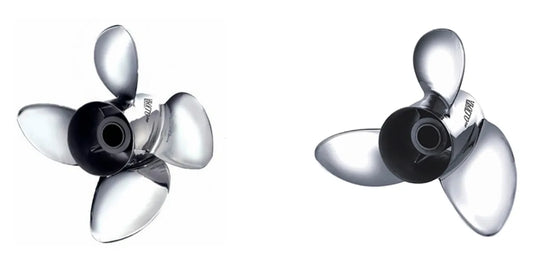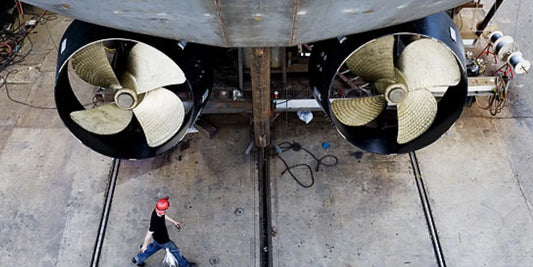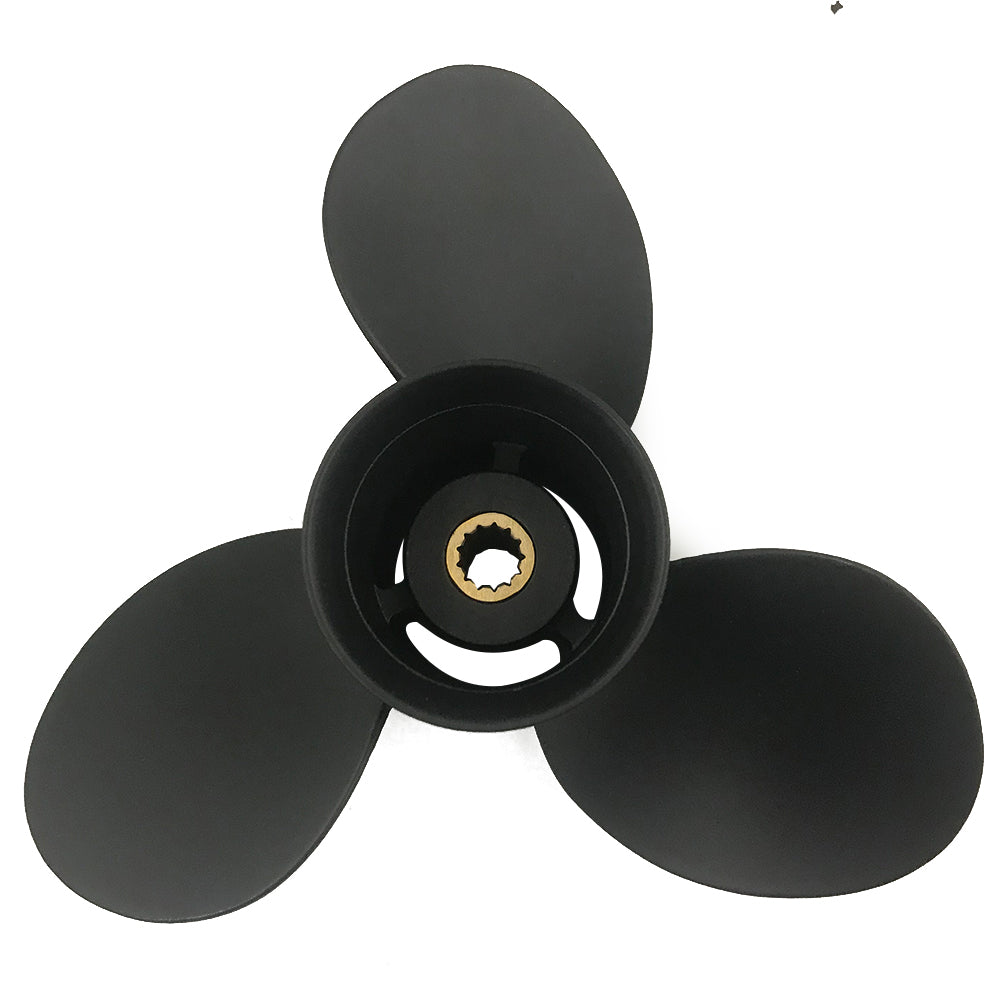An optimally performing boat comes with several distinctions, one being the choice of a particular propeller. Among some frequent material choices remain stainless steel and aluminum; yet, which one shall suit yours? Several factors should be considered when determining the right prop, including durability, price, efficiency, and the specific nature of the boating activities you'll be engaged in. This article examines propellers made of steel and aluminum in detail, enabling you to make the best decision possible. Whether speed, fuel optimization, or maximum durability is on your mind, we'll weigh the benefits and compromises of each to help you find the best choice for your application.
Understanding Propellers

What is a Boat Propeller?
Boat propellers refer to spinning devices that acquire rotational energy from boat engines to propel them forward through the water. Typically, they have several blades around a central hub, and their design affects factors such as speed, efficiency, and maneuverability. The performances of propellers depend chiefly upon the pitch of the blades, diameter, material of construction, and the number of blades used. High pitch usually equates to higher speed, while low pitch usually equates to higher acceleration.
Today's propellers have been developed through multiple hydrodynamic testing and engineering innovations and are available for specific uses, such as recreational boating, fishing, or water sports. Material considerations are mostly aluminum and steel due to their strength, resistance to corrosion, and general performance. For example, stainless steel is the best choice for high-stress conditions due to its high level of engineering durability and efficiency, while aluminum is a more cost-effective alternative for casual use. Understanding these technicalities will enable you to purchase a propeller that delivers the optimal engine power and performance for your boat and its specific application.
Types of Boat Propellers
Boat propellers come in several types, designed to provide optimal performance under specific conditions and for particular uses. Such knowledge will aid you in the choice of the right propeller to meet your boat's requirements.
Three-Blade Props
These are the most common and flexible propellers, offering a good balance between speed, efficiency, and durability. These propellers excel at performing at different speeds and, therefore, are considered among the best choices for recreational boaters seeking consistent power under varied water conditions.
Four-Blade Propellers
A four-blade propeller is chosen for stability, rapid acceleration, and enhanced handling in rough water conditions. It also delivers mid-range performance and offers improved grip for water sports or towing. Moreover, it tends to provide a smooth ride but may compromise on stability for top speed and efficiency.
Cupped Propellers
If cupping is present on your propeller, it simply means that the trailing edge of the blades is bent upwards. This small detail allows for a more substantial bite from the water. It increases efficiency with reduced ventilation and is best suited for boats that approach the upper limits of horsepower or are heavily loaded and sharply turning.
High-Speed Propellers
These propellers are designed to achieve maximum speeds and agility. They are often made from specialized materials, with blade angles and designs created to reduce drag while enhancing thrust. In effect, these propellers are primarily used for racing boats or vessels where maximum speed is crucial.
Weedless Propellers
A weedless propeller is fitted with blades designed to avoid snagging on underwater vegetation. These are found in shallow or highly vegetated waters, preventing unnecessary interruptions to the motor's smooth running.
Stainless Steel Vs. Aluminum Propellers
As far as the material is concerned, it greatly affects their performance. Stainless steel propellers are stronger and have a longer lifespan, making them preferred for high-speed or high-stress applications. Aluminum propellers have lower durability but are lightweight, cheap, and are often used for general recreational purposes.
When selecting a boat propeller, some other factors to consider for proper selection include pitch, diameter, and power output of the engine involved.
Importance of Choosing the Right Propeller
Choosing the right boat propeller at the right time is surely going to alter the fuel economy, handling, and overall performance of the vessel. When correctly matched, a propeller allows an engine to operate within its preferred RPM range, avoiding both overload and underutilization. For example, improperly pitched and sized propellers can increase fuel consumption by 15% to 20%, as found by research scientists, which is a significant cost in the long run.
Likewise, selecting the right material and design can make a significant difference in terms of durability and performance. For the harsher conditions, stainless steel propellers, with their hydrodynamic perfection, generate phenomenal thrust and resist wear like no other. Aluminum propellers have been recently designed for enhanced efficiency and cost, offering an ideal option for casual boaters.
Considering factors such as engine power, hull construction, and water conditions can lead to enhancements in the overall craft, thereby improving safety and reducing maintenance costs. Maintenance schedules should also include periodic checks and realignments of the propellers to ensure continued peak performance.
Materials Used in Propeller Manufacturing

Stainless Steel Propellers
The boating industry holds stainless steel propellers in very high esteem because of its strength, durability, and performance. Compared to aluminum propellers, stainless steel offers greater resistance to wear and corrosion, making it the preferred choice for both freshwater and saltwater conditions. Due to the rigidity of this material, designers can develop more intricate and refined blade profiles, thereby enhancing overall efficiency and reducing cavitation.
Factors that support the proposition that stainless steel propellers improve fuel economy for a vessel include reduced flexing during actual operation. The advanced design and materials enable higher top speeds and improved acceleration when paired with high-performance engines. Although stainless steel propellers carry an initial high cost, they do, however, rank high as a cost-effective investment in the long term, as they exist for a much longer period and retain their performance throughout this lifespan. Polishing, along with ensuring proper fitment, will further enhance their utility and keep inter-island vessels operating at peak performance.
Aluminum Propellers
Since these are affordable, lightweight, and versatile propellers, boat owners tend to prefer them. These are generally cast from strong aluminum alloys, which provide a balance between strength and cost. They are suitable for smaller boats and engines that do not require the ultimate durability of stainless steel counterparts.
This type of propeller ensures dependable performance for recreational activities such as fishing, cruising, and waterskiing, making it a good choice for casual boating. Aluminum propellers can be repaired more easily compared to stainless steel ones, and therefore, this may help reduce maintenance costs should an incident occur.
Industry changes and improvements have led to better design, the blade geometry, or even with variable pitch, would somehow affect fuel efficiency while retaining anticavitation capability. Thus, aluminum propellers, when coated with anticorrosive coatings, maintain their performance in both freshwater and saltwater; this also increases their lifespan when properly maintained.
Aluminum propellers may indeed be less capable of reaching top speeds and carrying heavy loads than stainless steel varieties. However, they are still a great choice in terms of reliability and economy for many boating applications, especially for those focused on low maintenance and budget-friendly pricing.
Comparison of Material Properties
It is crucial to consider properties such as durability, efficiency, price, and suitability for the application when comparing possible materials for propellers. What follows is an extensive comparison between the two most common materials:
| Property | Aluminum Propellers | Stainless Steel Propellers |
|---|---|---|
| Durability | Lightweight indeed, aluminum can be strained into bending or chipping when it is slammed against underwater debris, so frequent checks are recommended to ensure proper functioning. | Known for its strength, stainless steel propellers withstand impacts better than aluminum ones, making them a preferred choice for high-performance or demanding situations. |
| Efficiency | Suitable for casual use, providing fairly good efficiency at medium speed but not quite optimized for high performance or bearing heavy loads in demanding situations. | Rarely might a propeller compete with it in terms of its high efficiency. The blades can be designed accurately to achieve optimal performance in terms of speed, fuel economy, load-carrying capability, and compatibility with both fresh and saltwater. |
| Cost | Cheaper than other metals with which a propeller can be fabricated, aluminum propellers are the choice for boat owners or entry-level applications with a tight budget. | Although they may be expensive initially, the service life, enhanced performance, and utmost utility make the price worth paying, particularly for frequent or performance-oriented users. |
| Maintenance | Aluminum requires little maintenance, yet care must be taken to prevent oxidation. A corrosion-resistant coating is usually applied for protection. | Periodically clean and inspect to avoid marine growth accumulation and maintain efficiency while resisting corrosion better compared to aluminum, which lacks a coating. |
| Applications | Enjoying out-of-the-way areas for recreational boating and occasional fishing trips are the primary applications where price and ease of use take precedence. | Basically, it is suitable for high-speed boating, water sports, or any high-speed performance applications using big powerful engines. |
The need to match the material to the true boating conditions and performance expectations emerges in this comparison so as to realize an initial cost versus maintenance consideration and a penalty versus what one really wants. All materials, therefore, serve one purpose or another, so evaluating individual needs is critical to making an informed choice.
Performance Differences: Stainless vs Aluminum

Speed and Efficiency
When considering stainless steel versus aluminum propellers for speed and efficiency, four key cases need to be considered. Steel propellers transfer engine power to thrust with greater efficiency, primarily due to their rigidity. This solidity maintains blade geometry under high pressures for greater acceleration and top speed performances. Aluminum propellers offer some flexibility, but that slight deformity under high pressure may also slightly diminish efficiency; hence, they present smoother operation at lower speeds or in moderate scenarios.
Under similar conditions, stainless steel propellers are reported to produce a 3-5% increase in speed and fuel efficiency compared to aluminum propellers. Such advantages make stainless steel propellers a suitable choice for high-performance vessels where speed and accuracy are required. Conversely, aluminum propellers remain a more affordable alternative for barges operating at moderate speeds, emphasizing affordability without compromising practicality.
Durability and Resistance to Corrosion
When considering propellers for durability and resistance to corrosion, steel propellers are the first choice, thanks to their material properties. Stainless steel offers superior strength and hardness to deformation against stress, such as the sudden impact of underwater objects and debris, while aluminum is much more prone to deformation. Such advantages offer more usable life and, therefore, fewer replacements and repairs, which would be important for both leisure and working vessels.
Next in line is corrosion resistance. Being highly resistant to corrosion, particularly in saltwater where harsh elements would significantly tarnish any material, stainless steel is highly regarded. Chrome in stainless steel forms a passive layer for protection, preventing the formation of rust and thereby guaranteeing impeccable performance with time. Aluminum propellers, on the other hand, do weather away and are susceptible to corrosion; however, specialized coatings can improve their resistance. Therefore, for vessels primarily operated in lakes or low-salinity areas, aluminum remains a viable option, and it is quite inexpensive at that.
Selecting between stainless steel and aluminum is primarily determined by the specific operating conditions anticipated, as well as the vessel owner's long-term considerations. Stainless steel sits in there where power is maximized and corrosion resistance is retained, the hard applications. Aluminum is offered as an economical alternative for easier work.
Weight and Handling Characteristics
Density plays a major role in the evaluation of the weight and handling characteristics of stainless and aluminum steel. Since stainless steel has a density of approximately 8,000 kg/m³, it is significantly higher than that of aluminum, which is approximately 2,700 kg/m³. Weight significantly affects performance and design in vessels and structures that utilize stainless and aluminum materials. Aluminum, being lightweight, lends itself well to aiding activities and maintaining a balance between fuel efficiency, making it the preferred choice in applications where weight is a key factor.
On the contrary, the heavier nature of stainless offers higher stabilization and durability qualities, especially under situations of hefty loads or in turbulent operating conditions. Aluminum, being the lighter material, is easier to handle and thus puts steel at a disadvantage in terms of faster fabrication and installation. Whereas stainless steel shines when strength, resistance to deformation under stress, and long-term durability in harsh conditions are the requirements. Evaluating these factors determines the right material for a project's specific needs.
Cost Considerations

Initial Purchase Price
In terms of initial purchase price, aluminum is usually an affordable material. Because aluminum weighs less, it is generally cheaper to buy by the pound and is therefore ideal in projects requiring a large quantity of material. Stainless steel, on the other hand, with its durability, corrosion resistance, and strength, buys the quality price. Since the price difference might deter the use of stainless steel in small applications or where cost is crucial, it is often regarded as a worthwhile investment in industries that cannot afford to compromise on material longevity and performance. It is therefore a matter of weighing short-term budgetary considerations against the individual project requirements and anticipated service life.
Maintenance and Repair Costs
Being rust-resistant, stain-resistant, and corrosion-resistant, stainless steel is typically the more economical option for maintenance and repair. Where time and harsh environmental conditions may quickly degrade substitutes, stainless steel typically requires less consideration in chemical processing plants or marine applications. Industry standards stipulate that it is sufficient to wash down a stainless steel surface with clean water and mild detergent to keep it in good condition. This may result in fewer repair costs and downtime periods, leading to lower operational expenses.
On the contrary, materials like regular steel or aluminum may require frequent maintenance, such as repainting, changes to existing coatings, or repairs due to corrosion. Such maintenance processes increase the life-cycle costs of assets and project timelines, especially for large-scale operations. A smart choice, therefore, can be stainless steel, as it minimizes upfront costs and reduces the need for periodic maintenance on projects, thereby ensuring life-cycle costs are within affordable ranges.
Long-Term Value Analysis
In the study of long-term value, considering material durability and performance over time is well deserved. Stainless steel offers the highest degree of resistance against factors that cause corrosion, temperature-related aging, and weathering. This ultimate resilience allows each repair to become merely marginal, extending the lifespan of the structures and causing fewer interruptions due to maintenance.
In addition, studies recognize that materials with low depreciation rates, such as stainless steel, go to sustainable building practices. For industries striving for maximum operational efficiency, retaining functional use without replacement implies lower resource consumption and reduced environmental impact. Material choice based on longevity and performance results in a measurable ROI(bottom line), alongside fulfilling current sustainability criteria.
Choosing from the spectrum of materials specially designed for longevity from the very inception allows a business to strategically set projects that withstand physical challenges, including ongoing alterations to compliance requirements, and hence to lay a firm foundation for long-term value.
Choosing Between Aluminum and Stainless Steel

Factors to Consider for Your Boat Type
Depending on your choice of aluminium or stainless steel for your boat, these factors should influence your decision to maximize performance, durability, and cost:
Corrosion Resistance
Aluminum exhibits passive corrosion resistance; therefore, it is preferable for freshwater environments. However, in saltwater, aluminum requires a protective coating or anodization to prevent oxidation. Steel such as type 316 stainless steel will resist corrosion in saltwater, hence it is used where the marine environment is subjected to severe saline conditions.
Weight and Performance
Compared to stainless steel, aluminum is noticeably lighter, reducing the overall weight of the boat and making it more fuel-efficient as well as easy to handle. Hence, it can be a favorite for smaller boats or vessels operating at high speeds. Stainless steel is heavier than aluminum but stronger in terms of rigidity; it is used where components must withstand high load-bearing requirements.
Cost and Maintenance
Aluminum is often cheaper initially and easier to work with, resulting in lower production costs. However, under certain conditions, it may require frequent maintenance or treatment. Stainless steel, although more expensive initially, requires considerably less maintenance over time, resulting in lower costs in the long run.
Structural Strength
For applications demanding maximum structural integrity, stainless steel often provides a better and more durable solution for critical components, such as fittings, rails, and anchors. Aluminum is suitable for applications entailing less stress, such as hulls and panels.
Aesthetic Appeal
Stainless steel offers a polished and sleek appearance, maintaining the aesthetic value of your boat for a long time. Aluminum, being functional and usually painted, may look less attractive when aesthetics are a concern.
Ultimately, aluminum versus stainless steel will depend on the specific demands of your boat type, its operating environment, and more broadly, its maintenance and cost considerations. With these factors taken into account, the vessel will be set up for peak performance and longevity.
Performance Needs and Usage
Performance needs and usage scenarios are always top priorities for the vessel and the environment in which it operates. For example, when the boat is frequently exposed to saltwater conditions, I tend toward stainless steel because it offers excellent corrosion and rust resistance, which is essential if you expect the component to be dependable over long use. If weight and price are bigger concerns, then aluminum becomes irresistible due to its light weight and competitive price. This is the preference that may be suitable for small vessels or applications where reducing overall weight is crucial for optimal performance.
Plus, the very usage of my ship weighs heavily on a given choice. Where high-speed or performance-oriented action places out high demands of durability, and then the opposite—in lightweight and strength—there I imagine aluminum in a big role. However, where maximum reliability and long wear under heavier loads are required in the marine environment, stainless steel is the obvious choice. In balancing these needs, I strive to combine materials that not only meet my expectations but also contribute to the long-term success of the craft.
Expert Recommendations and Best Practices
The evaluation of the best materials for any project, in my estimation, begins with a careful assessment of the specific actual needs of the application. If the application were to ask for an average combination of strength, corrosion resistance, and weight savings, I would consider aluminum. It is a material that can be excellently versatile and suits well in environments that are not very harsh or demanding, such as mild exposure to moisture or salt. I believe it could withstand a variety of usages reasonably well if properly cared for, maintained, and treated, making it a cost-efficient aluminum option from a weight standpoint.
For applications demanding maximum strength and wear resistance, especially in environments that require resistance to corrosive conditions such as marine environments, I choose stainless steel. In terms of superior strength and ability to endure harsh weather conditions, including exposure to saltwater, stainless steel tops the chart, ensuring long-term performance and reliability. However much your extra weight and upfront cost may be, stainless steel provides extreme dependability and can be justified in those critical structures or components that must last forever in the most demanding environments.
The entire approach involves weighing trade-offs between weight, strength, corrosion resistance, and cost for each specific application. Materials that complement the actual project goal and environmental conditions will always be preferred for enhancing the chances of a project's successful realization. The decision can tilt toward aluminum for the lightweight efficiency or toward stainless steel for its strength and reliability. Still, I like to think that I always choose the correct balance that ensures performance and value.
Frequently Asked Questions (FAQs)
Aluminum versus Stainless: What's the Difference in Propeller Materials?
The distinction between Aluminum propellers and Stainless Steel propellers lies primarily in the properties of their materials: stainless steel propellers are generally hardened against corrosion and thus more suitable for saltwater environments. Aluminum propellers, however, tend to be lighter and less expensive, but may not be able to withstand greater horsepower or shallower water conditions. Choosing between aluminum and stainless steel will depend on your specific boating needs, including the type of vessel and the intended use. Performance aspects include better fuel economy and top speed with stainless steel, as aluminum props are faster and easier to change and to repair.
What effects does using a stainless steel prop make on the boat's performance?
Stainless-steel propellers can significantly enhance a boat's performance because they possess rigidity and maintain their shape under high torque and RPMs. Their rigidity allows them to accelerate more effectively and achieve higher top speeds; hence, they are preferred by a boater seeking the best performance. Additionally, stainless steel props typically have thinner blades than aluminum, which reduces drag in the water and improves fuel efficiency. They can be expensive, though, and likely to be damaged if you hit anything in the water. Therefore, seriously considering a stainless steel prop as an upgrade is a worthwhile investment.
What are the advantages of an aluminum propeller?
Many benefits of aluminum props exist, especially for recreational boaters. Generally, they are less expensive than stainless steel props, making them an appealing option for those on a tight budget. They are also preferable regarding repairs and replacement, considering only minor impacts and resulting in minimal damage. They are lightweight, which helps boats work with lower horsepower or in shallow waters. And, since aluminum may not perform quite like stainless steel nor guarantee the same level of durability, yet, they are reasonably priced and practical, and thus remain widely chosen by many boat owners.
Can you fit a stainless steel prop on an outboard with low horsepower?
Yes, it could be fitted with a stainless steel propeller and one of the lower-horsepower motors, though at times it may not be the best choice. Stainless steel props are designed for performance and therefore may translate to a slight increase in speed and efficiency. However, if the motor's power is insufficient to realize the capabilities, it will increase drag. Consider your motor specifications and boating applications. For smaller outboards, aluminum props may be your best choice, as they provide just enough thrust without placing excessive stress on the motor. Always consult your local prop shop for advice on the right propeller for your setup.
Should I get a three-blade or a four-blade prop?
Choosing between a 3-blade and 4-blade prop depends mainly upon the style and performance characteristics demanded by the boat user. Typically, 3-blade propellers are more efficient at higher speeds, offering greater speed and fuel economy at the top end. In contrast, 4-blade propellers often deliver better acceleration and handling in rough water or, occasionally, in shallow-water operations. If you often require a higher torque for towing, or your boat needs better control at lower speeds, a 4-blade may be the right choice for you. If speed and fuel economy are more important to you, you should probably opt for a 3-blade prop.
Are aluminum and stainless steel props interchangeable?
Aluminum and stainless steel props cannot be directly interchanged, as their designs and material properties differ greatly. Each type of propeller is optimized for specific performance criteria and applications. While it is, in theory, possible to mount an aluminum propeller on any boat meant for a stainless steel propeller, that may not be the best option in terms of performance. Pitch, diameter, and blade design can be the deciding factors when choosing the right propeller for your boat. You must work alongside a prop expert or local prop shop to identify the best options for your boat and motor setup so that you get exactly the performance you want, for safety reasons.


